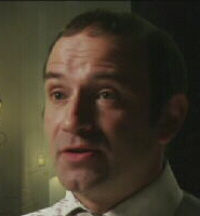Frances Coles
Swallow Gardens
Richard Jones
Richard Jones "The fact that the Mary-Jane Kelly inquest was over so quickly did starve the press of the lurid speculation of going after the
witnesses. So, rather than escalate, after what was the most vicious of the Ripper killings, the press reporting begins to fizzle out."
What we do know, is that there were more murders, some could have been the work of Jack the Ripper. First the murder of Rose Mylett whose body was
discovered in Poplar that December. Though apparently strangled, just as Ripper's victims appeared to be, she wasn't mutilated.
The head of the CID, Robert Anderson, certainly didn't believe that the Ripper had anything to do with it.
Then there was the killing of Alice McKenzie in the middle of the following year. This one bore all the classic signs of the Ripper's signature.
The discovery of a woman's dismembered torso in September 1889, in an area surprisingly close to Berner Street, sparked yet another Ripper scare.
But the final, significant, Whitechapel murderer occurred in February 1891. Swallow Gardens had once been a rural location. But, by 1888 it was little
more than an alley running under a railway arch. It was here that young Frances Coles was found, with her throat cut.
Frances Coles
Richard Jones "The immediate suspect was a sailor by the name of James Thomas Sadler, he and Coles had spent several days together going around
various pubs getting drunk. They'd argued, they'd split up. Within an hour of Frances Coles body being discovered he turned up at the lodging house
a little bit dishevelled and blood-stained and the police arrested him on suspicion of having murdered Frances Coles. He was even put into an
identity parade although he wasn't subsequently identified."
Although press interest waned, the police continued their investigation. To city detectives Cox and Sagar both later gave accounts of suspects the
believed to have been Jack the Ripper.
The murder of Frances Coles marked the official closure of the police investigation of the Whitechapel murders.

Don Rumblelow
Don Rumblelow "The Ripper files were closed in 1892, 4 years after the murders. Because there had been no solution, the case papers were simply
put away. Which just means that they could have been reactivated at any time if new information came forward"
For the last 100 years the question of who is Jack the Ripper? Has been one of the greatest unsolved puzzles in the annals of crime generating
volumes of comment, analysis and speculation. But, in fact, there were a number of suspects. And some senior policeman actually believe they knew
the identity of Jack the Ripper.
With the casebook of 14 unsolved murders, the police continued to examine the evidence and several believed that they had the answer to
Britain's biggest unsolved crime.
Dr Francis Tumblety
Richard Jones "In 1913, the journalist George Sims wrote to the then retired chief inspector John Littlechild and asked him if he is familiar with a
Dr D in connection with the Whitechapel murders"
Littlechild wrote back "I have never heard of Dr D but amongst the suspects, and to my mind a very likely one, was Dr T. Which sounds much like
a D . He was an American quack named Tumblety and was, at one time, a frequent visitor to London."
Dr Francis Tumblety was wildly eccentric and dressed flamboyantly often wearing a uniform. And, was noted for his huge moustache. He was also
homosexual at a time when it was illegal.

John Bennett
John Bennett "He was arrested for acts of gross indecency with several men, but he skipped bail and eventually returned to America"
Richard Jones "It's very rare for a homosexual serial killer to kill women. There victims tend to be other homosexuals"
Melville McNaughton who'd been assistant chief constable of the Metropolitan police just after the murders wrote a report in 1894 naming two
probable suspects. Their names were Druitt and Kosminski.
Richard Jones "Montague John Druitt was a barrister who was also working as a schoolteacher in Blackheath. He was dismissed for reasons we
don't know at the end of November 1888. Shortly after that, he committed suicide"
Melville McNaughton said that Druitt was sexually insane and hinted at information that suggested that his own family thought that he was
the Ripper. McNaughton favoured Druitt is Jack the Ripper but today, nobody knows why. What we do know, is that if the Druitt was the murderer
he must have been a very cool customer. Within hours of the murderer of Annie Chapman, just a few miles away in Blackheath, he was playing cricket.
Aaron Modke Kosminski
As for McNaughton's other suspect, the man known as Kosminski, a Polish Jew resident in Whitechapel.
McNaughton "This man became insane owing to many years of indulgence in solitary vices. He had a great hatred of women, especially of the
prostitute class, and had strong homicidal tendencies. He was removed to a lunatic asylum about March 1889. There were many circumstances connected
with this man that made him a strong suspect."
What we do know, is that Robert Anderson, the head of the CID at the time of the murders later wrote in his autobiography that not only was
Jack the Ripper a Polish Jew but that he had been positively identified by an eyewitness.
To the frustration of historians, Robert Anderson did not name his suspect but, chief inspector Donald Swanson the man who had overall
responsibility for the investigation did. In 1987, Donald Swanson's personal copy of Anderson's autobiography came to light.
Nevel Swanson
Nevel Swanson "Donald Swanson was my great-grandfather. The book by Anderson had been found with my great-grandfather's notes on it."
Swanson had made some pencilled notes in the margin, and he named Anderson suspect as Kosminski.
Who was Kosminski? A careful search of the Asylum records by the author Martin Fido produced only one Kosminski - Aaron Modke Kosminski.
Robert Jones "the Kosminski's were not a poor family. They were master tailors and did make a reasonable living and income in the East End of London"
The family ran a tailoring business in Greenfield Street in 1888. And, it's probable that Aaron lived there, placing him at the epicentre of
the crimes and only a matter of 600 yards from the murder of Elizabeth Stride.
In 1890, his brother Woolf admitted him to the workhouse infirmary where he was described as being insane for two years.
It is clear that by 1891, when Kosminski was admitted to the Asylum that he was not well enough to have committed the murders attributed to
Jack the Ripper. But, that did not mean that he might not have been capable two years earlier.
Did Jack the Ripper escaped the clutches of the law because his family committed him to an asylum? We may never know, but we have followed
the footsteps of Jack the Ripper into the dark labyrinth of London's past.

